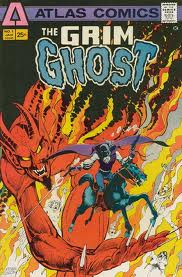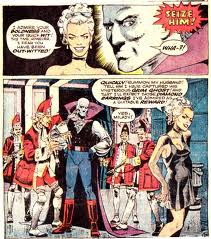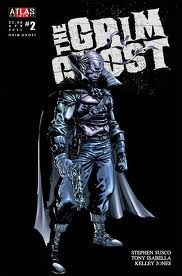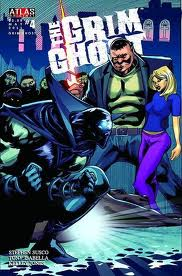Comic books basically invented the superhero genre, and that genre spread to prose and especially movies. Comics didn’t create good-guy horror, but they made the topic a genre and gave it a home.
By good-guy horror I mean horror in which the reader’s sympathies are with the monster. Naturally, Mary Shelley seems to have invented the genre with Frankenstein, or The Modern Prometheus. You read the book and your sympathies are with Frankenstein’s monster.
But there was no such sympathy for the other standard monsters of horror. Vampires, werewolves, zombies, and the like were there to be a problem for courageous people to solve. Dracula was never a hero, not even in Tomb of Dracula.
But comics did take up good-guy horror in February 1940 with the debut of the Spectre. The Spectre was Jim Corrigan, a detective who was murdered trying to rescue his fiance from gangsters. Corrigan’s spirit was sent back to Earth, apparently by God, to stop all crime. It’s kind of a narrow focus. He could stop that crime by any means he felt like at the time. Which is kind of a lot of authority.
As it was, the Spectre became a monster. He found criminals and killed them. And he killed them brutally, cruelly, and with a little bit of irony. The nature of the crime led to the nature of the punishment, but it was never truly quick. There was always that moment of horror as the execution took effect.
But the people he killed were themselves monsters. He killed murderers who had no remorse for what they did. Kidnappers. Nazis. Even terrorists in the modern era. The Spectre’s saving grace was that he protected the victims and the innocent. His terror was reserved for people who might as well get used to it because they’re going to hell, anyway.
Over time, comics presented other good-guy monsters. The monster could even be the victim. Look at Marvel’s Werewolf by Night. This comic (by Gerry Conway and Mike Ploog) started in 1974. It told the tale of Jack Russell, an eighteen-year-old who was cursed to be a werewolf. The earlier issues of the comic detailed his attempts to find a cure and keep himself from being exploited by an occult underground. Russell eventually overcame his demons and so, as a werewolf, could claw up people’s faces in the name of being a good guy.
There were other good-guy horror characters over the years. Deadman was a ghost who hunted the man who killed him. Morbius tried to cure himself of a fatal disease and wound up a living vampire. And there are others, not always the lead character of the comics they appeared in.
Enter Atlas’s the Grim Ghost, twice. Let me explain. In the thirties several of Martin Goodman’s companies produced comics. One of those was Timely. This company would evolve into Atlas in the 1950s. In the 1960s the companies coalesced into Marvel Comics.
Martin Goodman left the company largely in the hands of his own nephew, Stan Lee. But in 1974, he started a new comics company, Seaboard/Atlas. It lasted about nine months, had 23 color comics and 5 black and white magazines. None of its titles had more than 4 issues.
That should have been it, but Atlas Mark 2 always had a cult following. In October 2010, Jason Goodman, grandson of Martin, started Atlas Mark 3. He picked up three titles from Atlas Mark 2. Fewer titles, but so far Grim Ghost, Wulf, and the Phoenix have gone 6 issues, at least two better than their original runs.
Michael Fleisher created the Grim Ghost for Atlas Mark 2, though the third issue was written by Tony Isabella, and the art was always done by Ernie Colon. As he previously wrote the Spectre, the similarities of the two stories are interesting. The Spectre was told by (presumably) God to go send bad guys to hell. The Grim Ghost was told by the Devil to go send bad guys to hell. Where the Spectre is to rid Earth of crime, the Grim Ghost just has to give demons in hell something to do. Where the Spectre was a cop, the Grim Ghost was a bandit. But from parallel premises, very different stories were told.
The Grim Ghost is Matthew Dunsinane, a highwayman in colonial America. He wears a costume which is basically a ruffled white shirt, vest, riding breeches and boots, gloves, a high-collared cape, and a mask that seems to be a kerchief slipped over his head and tied at the back of his neck. He carried two single-shot flintlock pistols and rode a jet black horse.
There is no indication why he is a highwayman, but he does have two incentives. He gets a lot of money and he gets action. In the first issue Matthew Dunsinane stops a coach carrying Lord and Lady Braddock. He robs them and shows a libidinous interest in Lady Braddock. In the seventies the idea of sex playing this kind of role in a story was a couple categories beyond unusual. That libido proves to be his undoing.
Lord Braddock is furious. But his wife, a conniving woman, says she can bring him in if she’s rewarded. A party is held, Matthew Dunsinane attends in his civilian identity. When Lady Braddock retires and undresses herself, he shows up in costume. It’s a trap. Troops show up and about three weeks later, Matthew Dunsinane is hung.
But the Devil gives him an offer. Kill evil souls. Dunsinane figures the first person he kills will be Lady Braddock. However, the Devil sends the Grim Ghost to the twentieth century, when there’s lots of evil happening.
In the second issue some souls are sent off to hell and some subplots that will never come to fruition are seeded. In issue three, the Grim Ghost is faced with Brimstone, a demon who wants to overthrow Satan and rule in hell. The Grim Ghost must team up with Lady Braddock, which he doesn’t like. He is in fact defeated by Brimstone, but gets into the demon’s head. Brimstone learns that if he or the Grim Ghost defeats Satan, they will cease to exist. The knowledge alone seems to be enough because Brimstone then disappears.
So did the Grim Ghost until 2010. And all through this first run, Dunsinane/Grim Ghost is an unlikeable character. He is greedy, sees women purely as sources of satisfaction, and he never accepts the consequences of his own actions. He is an anti-hero, like Dracula in Tomb of Dracula.
Atlas was revived and the Grim Ghost was revived with it. The writing is by Tony Isabella (nice to see him back) and Stephen Susco. Art is by Kelley Jones. It is at this stage that the Grim Ghost becomes good-guy horror.
The Grim Ghost is still Matthew Dunsinane, but other than that it’s like Jay Garrick and Barry Allen. The costume changes are fairly minor; a change of gloves, the vest is played down, and the shirt’s more modern, too. But more important, the story no longer takes place on Earth or in hell. It takes place in the Fringe. Basically, the Fringe is purgatory. It’s where the souls of those who died with issues go to sort themselves out. Young people, mostly.
Matthew Dunsinae is here, and once again, he was killed by Lord Braddock. But there the similarities almost stop. Where in the original story he died in 1743, this time, Dunsinane lives about thirty years later. He is a highwayman called the Grim Ghost, wearing the costume. But this time he plies his trade in England.
He comes to the colonies to reform himself. But revolution is in the air. Dunsinane becomes the Grim Ghost again because, apparently, the American government is into terrorism. Braddock follows Dunsinane to the colonies. He catches Dunsinane and hangs him. Now Dunsinane tries to claim souls for the light.
So in that sense the Grim Ghost is even closer to the Spectre.
But in the Fringe, the Grim Ghost’s enemy follows him again. Lord Braddock tries to claim souls for the dark. Strangely enough, he takes the role the Grim Ghost originally played. But neither God nor the Devil has shown his face in the Fringe. Braddock is a cruel, aggressive man who delights in the suffering of others of whom he is contemptuous.
Lady Sarah Braddock is back, too. She is not in any way the conniving, cruel, and horny temptress she was first time around. The marriage with Lord Braddock was arranged, and she loves Dunsinane. She fears his hatred of her husband is turning him more and more into someone like her husband.
Into this mix comes Michael. He is a powerful soul, not up there with Dunsinane and Braddock, yet, but close. Michael wants to know who he was when he was alive. But he is a prize in the battle between Braddock and Dunsinane, and as they struggle, secrets start being revealed.
That is the basic premise of the modern Grim Ghost. There are changes and revelations in the story, and it’s well worth reading. Despite being from a smaller company, it’s probably the foremost example of good-guy horror.
Good-guy horror is when a flawed person seeks something good, and that means morally good. Someone or something keeps them from getting it. As a result the person becomes a monster, usually one taken from classic horror. The person then defends the innocent, fights the evil, and/or tries to find a cure for the change that’s overcome them.
The character may live on this Earth, but they will spend some time, possibly most of their time, in other worlds. This can be other planets but it will more often be other dimensions, higher planes, or places that are simply not that closely defined. If they are on Earth, it is grim, hopeless, and often victim to conspiratorial groups.
This is the premise for the Spectre, Deadman, Werewolf by Night, Blade, Hannibal King in Tomb of Dracula, Morbius the Living Vampire, and the Grim Ghost. That’s a fair few titles when you consider no one knew the genre existed. Now that I have discovered this genre that I have liked for years exists, I’d like to see more of it. Possibly under a better name.
D Jason Cooper was born in Canada, grew up in the US, and lives in Australia. He has written eight books, contributed to three anthologies, wrestled professionally twice, reads comic books, collects pens, and works for the state government. Guess which one he thinks does not enhance the human species. He has a new website: http://www.djasoncooper.com/home/






I used to have a large chunk of the Atlas/Seaboard line (none of the magazines, though) and, aside from Howard Chaykin’s The Scorpion, Grim ghost was one of the few titles I really liked. Most of the books were fairly derivative, but Grim Ghost was a bit different, and Ernie Colon’s artwork worked very well here. The new series sounds like it is borrowing a bit from the UK tv series Life on mars and Ashes to Ashes, in terms of the purgatory angle, if not in the basic plot. Of course, the strangest good guy horror is still probably Kirby’s Satan’s Six, eventually published by Topps.